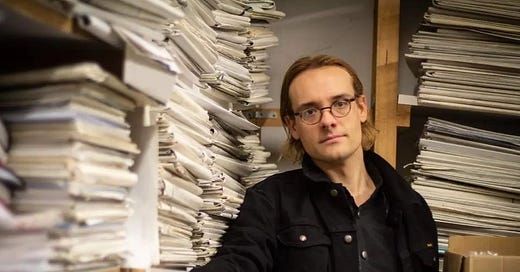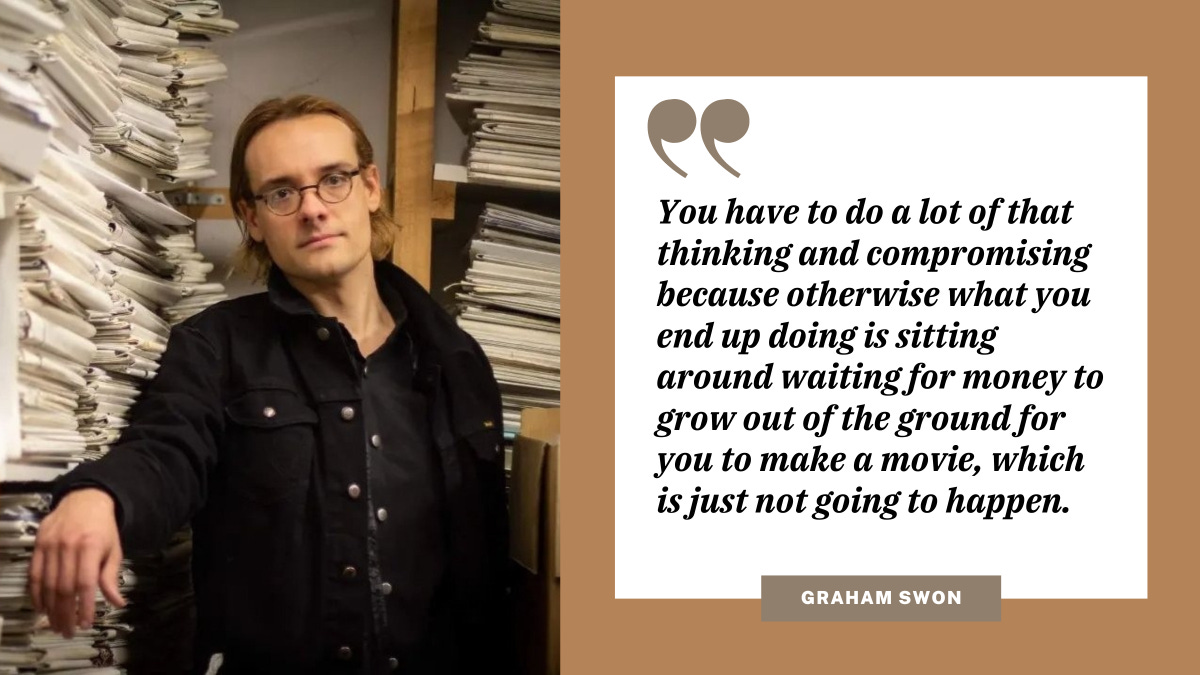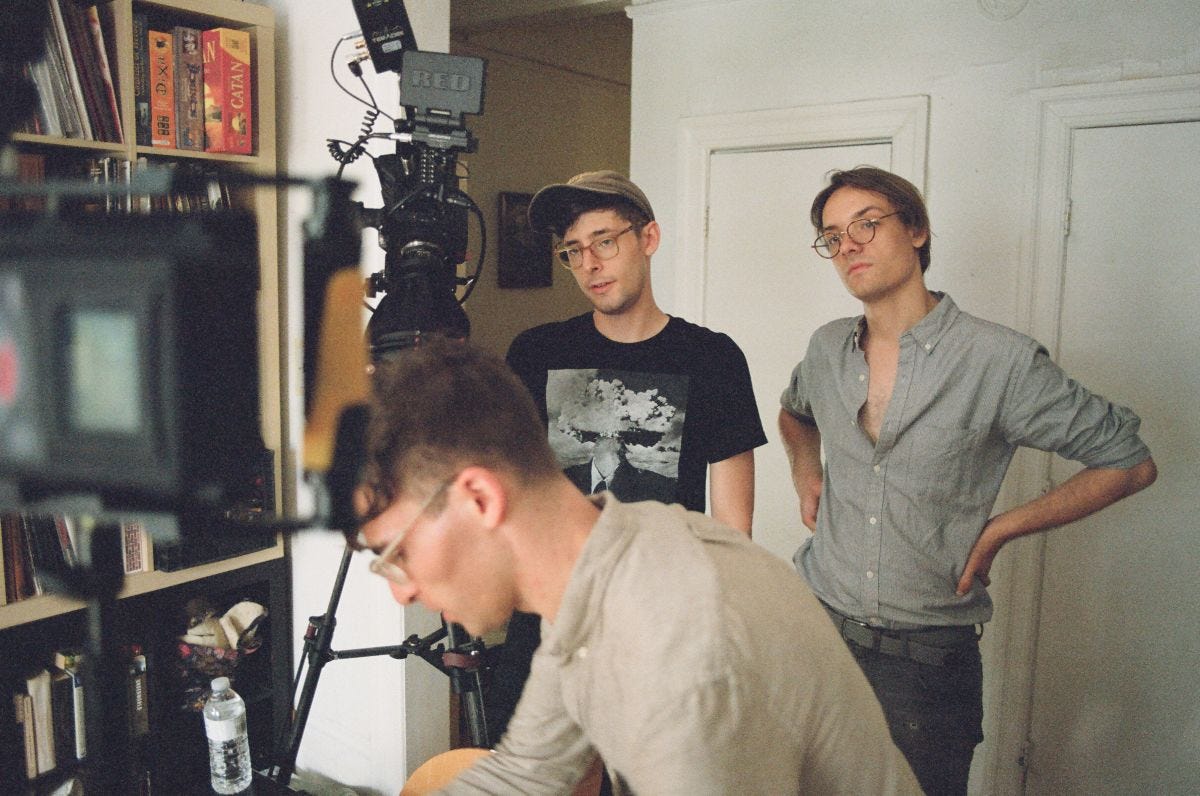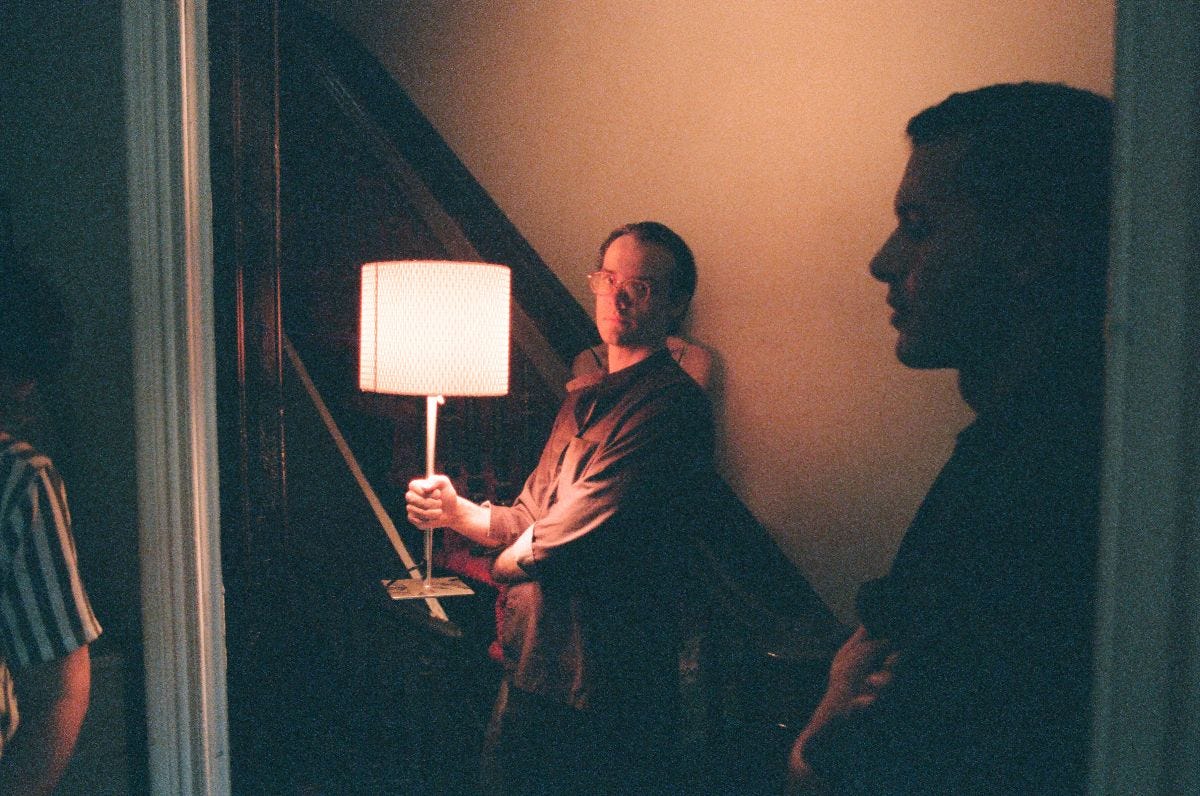Coming from the art house distribution world, Graham Swon draws on his background to inform how he measures success for the often niche or art house films he produces. In the face of continuing industry change, Graham sees great opportunity ahead, particularly for those who are nimble.
A nominee for the 2024 Producers Award at the Film Independent Spirit Awards, Graham Swon shares with Dear Producer the challenges of working within the US production system and how he reframes the production process to reflect his resources, rather than adhering to the way it’s done in Hollywood.
His new film as writer/director/producer, AN EVENING SONG (for three voices), is playing at First Look on March 17.
The films you’re producing tend to be more for art houses than commercial cinemas. Who is the audience for your films and where are they?
Each film has a different audience and a different financial circumstance. Some of the films I’ve produced exist primarily in the festival space, where we did special screenings rather than a conventional theatrical release. With a smaller budget film, or a very niche audience, that is the right approach because pushing a traditional distribution strategy is not going to net you or the distributor much of anything. As I moved from working in distribution to solely in production, I’ve become less US-focused in my thinking than I used to be. Partly because the films I’m producing frequently do better in terms of festivals and screenings in Europe than they do in North America. And yet, what remains the same is that you are still trying to get the film to screen as many places as you can and get as many people to see it as possible.
Something I’m even more aware of than I used to be is that despite the large focus on theatrical and festivals, particularly for directors, the large majority of people who see films, even a very niche art film, end up seeing them on VOD or DVD (should it exist). The filmmaking team and the distributor have this moment of focus on the film in the first year or two when you’re dealing with different types of releases. Yet it might be three or four years later when you realize that a community of people who respond to the film has emerged and it’s likely none of them saw the theatrical or original release.For me, the most important thing is to create as much space for each film as possible and support it to the best of my ability over time.
You’re coming into producing from distribution, specifically at Cinema Guild and Kino Lorber, where you were really focused on niche titles. You also have a background in theater directing. In both of those areas, there’s an understanding that the metric of success is variable, i.e. an art film is not going to gross OPPENHEIMER dollars and a local theater production does not need to be on Broadway to be enjoyed. How do those inform your approach to producing and how you define success?
The biggest rubric of how to determine whether a film is successful is, ‘did the director make the film they wanted to make?’ That’s the real line of success for me. The idea of making money is more of a bonus than a requirement. If my goal was to make money, I would not work on the kind of films I work on.
My decision to shift focus from theater to film was driven by my frustrations where I would work on a play that I thought was really amazing, then very few people would come to see it, and then it was done and over. That’s the nature of the medium, it’s very temporal, which is also what makes it great. But what attracted me to film is that the films continue to exist. As long as you take care of them and archive them properly, the films will exist forever. There are films I love that are really important to me that no one paid attention to when they came out and made zero dollars. Maybe it took 40, 50 years for that film to find an audience, but it eventually did with me. Films can still impact people years after they’re made.
You still have to think about money and sustainability in production because you want the director to make another film, but I’m not choosing projects because I think they will be monetarily successful, necessarily. It’s because I think the director has an important vision, or an interesting idea, or something unique within the film. After that, I figure out what’s the best we can do with it financially.
I feel this approach is part of protecting and nurturing the filmmaker and the film. Working out those financial things is part of protecting them, but if it ever superseded it, I would feel like I’m not doing my job right. For instance, I’ve made two films with the filmmaker Ted Fendt, who works on 16mm. He also prefers to exhibit on 16mm or 35mm. For his film CLASSICAL PERIOD, we made a 16mm print, which Ted regards as the film. However, it’s basically impossible to commercially exploit a 16mm print. We were able to find and show the film as it should be seen in as many places as possible, and then, as needed, some screenings on DCP. We built the finances around the 16mm version of the film, that was the prerequisite. It wasn’t a marketing decision, but Ted’s aesthetic decision, that I tried to find a way to support.
Given the types of projects you’re working on, are you able to sustain yourself through producing? Or are you finding yourself picking up other projects? How do you make it all work?
Each year, it gets slightly easier to sustain myself on producing, partially because I’m dealing with slightly bigger budgets. Even if I’m still paying myself effectively poverty wages, these poverty wages are a little higher than they used to be, just because the projects are bigger and last longer. I also do a bit of teaching and lecturing here and there. And I still edit trailers for a few distributors like Janus, Cinema Guild, Grasshopper, and Kino Lorber. It helps me stay in touch with the distribution and marketing world, which are important relationships, skills, and knowledge I can bring to my films.
Every year, every month honestly, ends up looking a little bit different. The other strategy I’ve tried to take is to find ways to lower my cost of living in ways that allow me to have freedom on the projects I’m working on. I realized if I wanted to live in a certain place and live a certain kind of way, I would need X income. But I’m more interested in working on the projects I care about and being able to give myself totally to them.
When I started producing, I was still working in distribution, so the distribution work supported me. I was not making any money whatsoever on the productions. It can be tough to make sure I don’t spend too much time on any one project or spread out my projects so that I’m getting paid more consistently over time. I don’t really consider this a career in the conventional sense, because I will continue to make movies even if I don’t make money.
Ricky D’Ambrose (foreground), Barton Cortright (left) and Graham Swon (right) on the set of NOTES ON AN APPEARANCE. Photo by Michael Kohlbrenner.
How did it feel when you found out you were nominated for the Producers Award?
I was really surprised and also very grateful. You do all this work and make the films, and then to have them not just seen, but recognized? For the most part, I’m used to the films getting the attention or the director getting the attention. I was surprised to have the attention turned on me. I’m very grateful to have my work recognized in that way because it is a lot of effort and sacrifice, and there is a very small number of people who really understand what producing is.
What do you see as the primary challenges to independent producing right now, particularly at the level of independent film you’re working in?
The big issue is almost always financing. Everything boils down to time and money, and then time basically also boils down into money. It all boils down into money at a certain point. One of the things that’s been a struggle for me increasingly is that I’ve worked with a lot of the same people over the years and we’re getting older. A crew of 20-somethings vs 30-somethings vs 40-somethings is very different in terms of crew compensation and working hours. Keeping the whole system sustainable costs money and money changes what is possible very quickly. Right now, a challenge is inflation. Having $300,000 to make a movie feels identical to having $175,000 three years ago. And yet it’s no easier to find that money.
Another thing to be said is that very frequently on these projects, the director is either drawing no salary or if they are, they’re redirecting it back into the film. That makes it hard to build careers and have people continue to make good work when they’re not able to feed themselves. How we can solve it, I don’t really know, because so much of the US system is built around commercial production. It’s built around the idea that a movie is by its nature, a profit-making entity.
There are lots of issues with the subsidy systems in other countries too, though, because you end up with films shaped by committee to a certain extent. They have to run down a certain checklist to get funding and it shows in the films. They do seem more sustainable for filmmakers, however, in that money exists for films to be made that are not driven by whether or not they will make a profit.
How do you make films where you understand your best case scenario is everybody getting paid and effectively the production not having debt? That’s generally my goal, to get to the point where the production doesn’t have debt. Ideally, you would roll into making another film afterwards, taking the profit from the first and putting it into the next, and so on and so forth. That can barely be done in American independent cinema. You’re really hand-to-mouth figuring out each production separately from each other.
A few years ago, I would have said there was potential for money through new forms of distribution and a pivot into more digital and democratic distribution of film. I’m less confident of that now because I think the digital space is rapidly closing off and becoming as gate-kept and challenging to get into as the theatrical space traditionally has been.
The other big issue is that a lot of indie productions try to mirror commercial productions in their structure. From their size of crew to the number of shooting days, the whole orchestration of how the production is done is basically a scaled-down version of a studio film, because that’s what everybody’s learned, that’s the way the system’s been built.
Directors want to work with a skilled professional crew. A skilled professional crew is going to act like the professionals they are and want a set organized in a certain way. There are a lot of valid reasons why sets are organized in the way they are in terms of efficiency and operational considerations of how these departments work. But unless either you as the producer, or the director and the producer together, decide to try to structure something differently, there’s a tendency for things to revert to the mean, to fall into, “This is how movies are made.” Especially if people either have worked professionally in crews, or if people went to film school, they were taught to make movies a specific way. It requires a little bit of adventurousness in terms of how you’re going to orchestrate the production to do things abnormally to work within a limited budget.
The system works within one financial system and it’s very challenging in certain independent spaces. I’ve done features with a crew of four people; you can do a film with a crew of one person if the content of the film is built to it. I’m always trying to think of the ways, with a given script, that we can sculpt the way the production is going to work to create what the film aesthetically needs, rather than just going through the motions of hiring these department heads who hire these assistants, who all do things the same way, and then we shoot on this schedule in this manner.
For example, the film FOURTEEN by Dan Sallit, which I co-produced with Caitlin Mae Burke, was shot in five sections of four days each. I’m not sure if I would suggest repeating this process because there were challenges related to it, but it came out of the desire of the director to have the seasons change during the film. In some ways, the most affordable way to approach it was to use the actual seasons.
We had about $100,000 and essentially made five short films rather than one feature. It required changing a lot of elements of the crew; not so much department heads, but we would have a different group of people every time. You have to restart production, which is challenging, but that was the kind of approach that we could take because we’re small. A bigger production could not afford to do that in a lot of instances.
Going back to Ted Fendt, who works on 16mm; he’s always working with a crew of only three or four. For the most part, the crew are the same people who have been on all his films, and they’re not necessarily professionally pursuing the roles they’re playing on that crew. It doesn’t look or feel like a commercial film set, but it allows Ted to create the material he needs to make those films.
Another example is Ricky D’Ambrose, with whom I’ve produced a short and two features. He had been trying to make his first feature, NOTES ON AN APPEARANCE, for seven or eight years. He would meet producers who told him his script would need between $300,00 – $400,000. They attempted to raise the money in a couple different configurations, but were ultimately never able to find the money.
Ricky and I were connected through another director I had worked with, and I really liked his script and loved his shorts. I sat down with him and as we went through the script, I would put a star next to everything that would cost an abnormal amount of money. That could be something obvious like a stunt or a special effect, or something as seemingly simple as a scene in a car. If you want to do a scene in a car with actors talking, you need a process trailer. If you need a process trailer, you need somebody to drive the process trailer, and then you need a whole bunch of material around that. Suddenly the simple scene of two people in a car has raised the budget of your film by $20,000.
It’s a matter of letting the director know which things will push this production into a larger scale. Yes, this script as-is can be made for $300,000 or $400,000, however, if we simplify things and move things around, we can reduce the budget. Can we do a driving scene with two characters walking? Can the car be pulled over? What makes sense in this context right now that we can simplify? A scene on a boat – can it take place on the dock?
It’s very delicate because you have to be sure you’re not aesthetically comprising the content of the film in order to lower the budget. I do think there’s a give and take relationship between the two things and that you can find a way to hold the aesthetic ideas in the film while not spending an exorbitant amount of money. We ended up making that film for $30,000.
I am very proud of that film, and Ricky’s very proud of that film. Are there things different about the final film versus the script I originally read? Absolutely. But my mindset was what amount of money do we have access to – it was about $30,000 – and how much do you want to make the movie this year? You have to do a lot of that thinking and compromising because otherwise what you end up doing is sitting around waiting for money to grow out of the ground for you to make a movie, which is just not going to happen.
Graham Swon (with lamp) and James N. Kienitz Wilkins (right) on the set of NOTES ON AN APPEARANCE. Photo by Michael Kohlbrenner.
Where do you think we’re headed next? What gets you excited about producing?
I think we are at one of these juncture points in the history of cinema, like the beginning of the sound era, where the silent system is superseded by the sound system and production completely changes and the aesthetics of movies changes rapidly. We saw that in the ‘60s when the studio system collapsed and we got New Hollywood, with this burst of new ways of making films, really interesting films. On a smaller scale, you could look at the independent film boom in the late ‘80s, early 90’s or even digital coming in and transforming the way production and post-production was handled.
I feel like on an industrial level, distribution, and production are building on these really old systems. They’re outmoded and they’re showing their rickety-ness in relation to the world right now. We could see a really big collapse in the industry soon, but that could create a big space for new types of films or new ideas of films. I don’t know what they’re going to be. That’s what is exciting to me. I welcome the death of the old guard, even though I know it will be painful in certain ways. I think about how I never really bothered to watch any YouTube, but in fact, it’s a new form of filmmaking. It’s a huge industry and it’s the primary thing that kids watch.
Oh yes. My two 9-year-old nephews want to be YouTubers when they grow up.
Exactly. Everyone I meet now says that same thing about the kids in their lives. Here’s this whole realm of filmmaking that is basically ignored by the film industry, and certainly ignored by the critical community. And then you have AI, VR, all these alternative communities. I’m pretty old-school in my taste, but I’m excited by all of it. It’s rare that there is as clean a dividing line as silent to sound, but I think we’ll see it here. It evokes questions about how things are made, how audiences receive film, and will it still exist.
It’s not the death of cinema. It’s the death of cinema as we know it, and that’s how it always works.
Absolutely. We’re at a pivotal moment in the death and rebirth cycle. I’m excited to see how that keeps coming out and what interesting things I can do within that space.







